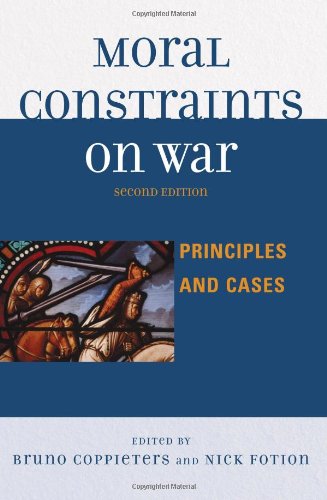

Most ebook files are in PDF format, so you can easily read them using various software such as Foxit Reader or directly on the Google Chrome browser.
Some ebook files are released by publishers in other formats such as .awz, .mobi, .epub, .fb2, etc. You may need to install specific software to read these formats on mobile/PC, such as Calibre.
Please read the tutorial at this link. https://ebooknice.com/page/post?id=faq
We offer FREE conversion to the popular formats you request; however, this may take some time. Therefore, right after payment, please email us, and we will try to provide the service as quickly as possible.
For some exceptional file formats or broken links (if any), please refrain from opening any disputes. Instead, email us first, and we will try to assist within a maximum of 6 hours.
EbookNice Team

Status:
Available0.0
0 reviews
ISBN 10: 739121294
ISBN 13: 9780739121290
Author: Nick Fotion
This second edition of Moral Constraints on War offers a principle-by-principle presentation of the trans-cultural roots of the ethics of war in an age defined by the increasingly international nature of military intervention. Parts one and two trace the evolution of Just War Theory, analyzing the principles of jus ad bellum and jus in bello: the principles that determine under what conditions a war may be started and then conducted. Each chapter provides a historical background of the principle under discussion, an explanation of the principle, and numerous historical examples of its application. In Part three, case studies apply the theories discussed to NATO's humanitarian mission in Kosovo, terrorism and the Iraq War.
Bringing together an international coterie of philosophers and political scientists, this accessible and practical guide offers students of military ethics and international relations rich, up-to-the-minute insight into the pluralistic character of Just War Theory.
Part 1: Jus Ad Bellum (Justice in Going to War)
Chapter 1: Just Cause
Self-Defense
Humanitarian Intervention
Preemption and Prevention
Case Study: The Invasion of Iraq
Chapter 2: Legitimate Authority
Who Has the Right to Declare War?
International Law and Sovereignty
Non-State Actors
Chapter 3: Right Intention
Pure Motives vs. Mixed Motives
Avoiding Vengeance or Greed
Chapter 4: Last Resort
Exhausting Non-Violent Options
Proportionality of Means
Chapter 5: Proportionality of Ends (Probability of Success)
Weighing Expected Benefits Against Costs
Feasibility of Achieving Goals
Part 2: Jus In Bello (Justice in Conduct of War)
Chapter 6: Discrimination (Noncombatant Immunity)
The Principle of Distinction
Defining Combatants and Noncombatants
Collateral Damage
Case Study: Aerial Bombing Campaigns
Chapter 7: Proportionality of Means
Avoiding Excessive Harm to Achieve Military Goals
Military Necessity
Case Study: Use of Specific Weapons (e.g., Chemical Weapons, Nuclear Weapons)
Chapter 8: Double Effect
Intention vs. Foreseeable Consequences
Applying the Principle
Chapter 9: Good Faith and Humane Treatment
Treatment of Prisoners of War
Prohibition of Torture
Respect for Surrender
Chapter 10: Non-Maleficence
Avoiding Wanton Destruction
Protection of Cultural Property
Part 3: Jus Post Bellum (Justice After War)
Chapter 11: Just Cause for Termination
Achieving War Aims
Unconditional Surrender vs. Negotiation
Chapter 12: Proportionality of Punishment and Reconciliation
War Crimes and Accountability
Reconstruction and Reparations
Forgiveness and Healing
Chapter 13: Re-establishing Legitimate Authority
Occupation and Nation-Building
Disarmament and Demobilization
Transition to Peace
moral constraints on war
moral construction
moral constraints
what are the moral implications of war
moral constraints examples
a moral conflict
Tags: Nick Fotion, Moral, Constraints